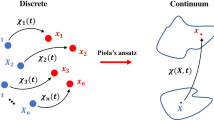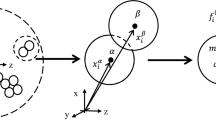Abstract
We have derived a stress–strain relationship for viscoelastic materials undergoing damage using a granular micromechanics approach. This approach assumes the material to possess a granular meso-structure such that the material is treated as a discrete or a particulate system. By considering the particle kinematics in terms of Taylor series expansion, a continuum model of the discrete system is obtained. The material rate-dependence and damage are modeled by assuming appropriate inter-granular force–displacement relationships that satisfy thermodynamic constraints. The advantage of this micromechanical approach is that the resultant continuum model retains the discrete nature by incorporating the effect of nearest neighbor grain interactions through the inter-granular force–displacement relationship and orientation vector. As a result, the derived model has the ability to predict a number of material phenomena, such as loading-induced anisotropy, dilation or pressure sensitivity, and secondary creep, which often manifest due to material granularity.
Similar content being viewed by others
References
Nemat-Nasser S., Hori M.: Micromechanics: Overall Properties of Heterogeneous Materials. North-Holland, New York (1993)
Navier C.L.: Sur les lois de l’equilibre et du mouvement des corps solides elastiques. Memoire de l’Academie Royale de Sciences 7, 375–393 (1827)
Cauchy, A.-L.: Sur l’equilibre et le mouvement d’un systeme de points materiels sollicites par des forces d’attraction ou de repulsion mutuelle. Excercises de Mathematiques 3, 188–212 (1826–1830)
Arndt M., Griebel M.: Derivation of higher order gradient continuum models from atomistic models for crystalline solids. Multiscale Model. Simulat. 4(2), 531–562 (2005)
Blanc X., Le Bris C., Lions P.L.: From molecular models to continuum mechanics. Comptes Rendus De L Academie Des Sciences Serie I-Mathematique 332(10), 949–956 (2001)
E W.N., Huang Z.Y.: A dynamic atomistic-continuum method for the simulation of crystalline materials. J. Computat. Phys. 182(1), 234–261 (2002). doi:10.1006/jcph.2002.7164
Misra A., Yang Y.: Micromechanical model for cohesive materials based upon pseudo-granular structure. Int. J. Solids Struct. 47(21), 2970–2981 (2010). doi:10.1016/j.ijsolstr.2010.07.002
Chang C.S., Gao J.: 2nd-gradient constitutive theory for granular material with random packing structure. Int. J. Solids Struct. 32(16), 2279–2293 (1995)
Alibert J.J., Seppecher P., Dell’Isola F.: Truss modular beams with deformation energy depending on higher displacement gradients. Math. Mech. Solids 8(1), 51–73 (2003). doi:10.1177/108128603029658
Seppecher P., Alibert J.-J., dell’Isola F.: Linear elastic trusses leading to continua with exotic mechanical interactions. J. Phys. Conf. Ser. 319(1), 012018 (2011)
dell’Isola F., Vidoli S.: Continuum modelling of piezoelectromechanical truss beams: an application to vibration damping. Arch. Appl. Mech. 68(1), 1–19 (1998)
Chang C.S., Askes H., Sluys L.J.: Higher-order strain/higher-order stress gradient models derived from a discrete microstructure, with application to fracture. Eng. Fract. Mech. 69(17), 1907–1924 (2002)
Askes H., Metrikine A.V.: Higher-order continua derived from discrete media: continualisation aspects and boundary conditions. Int. J. Solids Struct. 42(1), 187–202 (2005). doi:10.1016/j.ijsolstr.2004.04.005
Yang Y., Ching W.-Y., Misra A.: Higher-order continuum theory applied to fracture simulation of nano-scale intergranular glassy film. J. Nanomech. Micromech. 1(2), 60–71 (2011)
Murrell J.N., Carter S., Farantos S.C., Huxley P., Varandas A.J.C.: Molecular Potential Energy Functions. Wiley, New York (1984)
Chang C.S., Misra A.: Packing structure and mechanical-properties of granulates. J. Eng. Mech. Asce 116(5), 1077–1093 (1990)
Misra A., Chang C.S.: Effective elastic moduli of heterogeneous granular solids. Int. J. Solids Struct. 30(18), 2547–2566 (1993)
Triantafyllidis N., Bardenhagen S.: On higher-order gradient continuum-theories in 1-D nonlinear elasticity—derivation from and comparison to the corresponding discrete models. J. Elast. 33(3), 259–293 (1993)
dell’Isola F., Sciarra G., Vidoli S.: Generalized Hooke’s law for isotropic second gradient materials. Proc. R. Soc. Math. Phys. Eng. Sci. 465(2107), 2177–2196 (2009). doi:10.1098/rspa.2008.0530
dell’Isola, F., Seppecher, P.: Hypertractions and hyperstresses convey the same mechanical information. Continuum Mech. Thermodyn. 22, 163–176 (2010) by Prof. Podio Guidugli and Prof. Vianello and some related papers on higher gradient theories. Continuum Mech. Thermodyn. 23(5), 473–478 (2011) doi:10.1007/s00161-010-0176-3
dell’Isola F., Seppecher P.: The relationship between edge contact forces, double forces and interstitial working allowed by the principle of virtual power. Comptes Rendus De L Academie Des Sciences Serie Ii Fascicule B-Mecanique Physique Chimie Astronomie 321(8), 303–308 (1995)
dell’Isola F., Seppecher P.: Edge contact forces and quasi-balanced power. Meccanica 32(1), 33–52 (1997)
Suiker A.S.J., Chang C.S.: Application of higher-order tensor theory for formulating enhanced continuum models. Acta Mech. 142(1–4), 223–234 (2000)
dell’Isola, F., Seppecher, P., Madeo, A.: How contact interactions may depend on the shape of Cauchy cuts in N-th gradient continua: approach “a la D’Alembert”. Zeitschrift für Angewandte Mathematik und Physik (ZAMP) (2012). doi:10.1007/s00033-012-0197-9
Yang, Y., Misra, A.: Micromechanics based second gradient continuum theory for shear band modeling in cohesive granular materials following damage elasticity. Int. J. Solids Struct. (2012). doi:10.1016/j.ijsolstr.2012.05.024
Johnson K.L.: Contact Mechanics. Cambridge University Press, Cambridge (1985)
Chang C.S., Misra A.: Theoretical and experimental-study of regular packings of granules. J. Eng. Mech. Asce 115(4), 704–720 (1989)
Atanackovic T.M.: A modified Zener model of a viscoelastic body. Continuum Mech. Thermodyn. 14(2), 137–148 (2002). doi:10.1007/s001610100056
Rajagopal K.R., Srinivasa A.R., Wineman A.S.: On the shear and bending of a degrading polymer beam. Int. J. Plast. 23(9), 1618–1636 (2007). doi:10.1016/j.ijplas.2007.02.007
Breuer S., Onat E.T.: On the determination of free energy in linear viscoelastic solids. Zeitschrift für Angewandte Mathematik und Physik 184–191(2), 15 (1964)
Day W.A.: Reversibility, recoverable work and free energy in linear viscoelasticity. Q. J. Mech. Appl. Math. 23, 1 (1970)
Deseri L., Gentili G., Golden M.: An explicit formula for the minimum free energy in linear viscoelasticity. J. Elast. 54, 141–185 (1999)
Deseri L., Golden J.M.: The minimum free energy for continuous spectrum materials. Siam J. Appl. Math. 67(3), 869–892 (2007). doi:10.1137/050639776
Gentili G.: Maximum recoverable work, minimum free energy and state space in linear viscoelasticity. Q. Appl. Math. 60(1), 153–182 (2002)
Del Piero G., Deseri L.: On the concepts of state and free energy in linear viscoelasticity. Arch. Ration. Mech. 138, 1–35 (1997)
Christensen R.M.: Theory of Viscoelasticity: An introduction. Academic Press, New York (1982)
Darabi M.K., Abu Al-Rub R.K., Masad E.A., Huang C.W., Little D.N.: A thermo-viscoelastic-viscoplastic-viscodamage constitutive model for asphaltic materials. Int. J. Solids Struct. 48(1), 191–207 (2011). doi:10.1016/j.ijsolstr.2010.09.019
Zhou X.P., Yang H.Q., Zhang Y.X.: Rate dependent critical strain energy density factor of Huanglong limestone. Theor. Appl. Fract. Mech. 51(1), 57–61 (2009). doi:10.1016/j.tafmec.2009.01.001
Kuhn M.R., Mitchell J.K.: New perspectives on soil-creep. J. Geotech. Eng. Asce 119(3), 507–524 (1993)
Lade P.V., Liggio C.D., Nam J.: Strain rate, creep, and stress drop-creep experiments on crushed coral sand. J. Geotech. Geoenviron. Eng. 135(7), 941–953 (2009). doi:10.1061/(Asce)Gt.1943-5606.0000067
dell’Isola F., Guarascio M., Hutter K.: A variational approach for the deformation of a saturated porous solid: a second-gradient theory extending Terzaghi’s effective stress principle. Arch. Appl. Mech. 70, 323–337 (2000)
Dell’Isola F., Hutter K.: What are the dominant thermomechanical processes in the basal sediment layer of large ice sheets?. Proc. R. Soc. Lond. Ser. Math. Phys. Eng. Sci. 454(1972), 1169–1195 (1998)
dell’Isola F., Rosa L., Wozniak C.: A micro-structured continuum modelling compacting fluid-saturated grounds: the effects of pore-size scale parameter. Acta Mech. 127(1–4), 165–182 (1998)
Sciarra G., dell’Isola F., Hutter K.: A solid-fluid mixture model allowing for solid dilatation under external pressure. Continuum Mech. Thermodyn. 13(5), 287–306 (2001)
dell’Isola F., Kosinski W.: Deduction of thermodynamic balance laws for bidimensional nonmaterial directed continua modelling interphase layers. Arch. Appl. Mech. 45, 333–359 (1993)
dell’Isola F., Romano A.: On the derivation of thermomechanical balance-equations for continuous systems with a nonmaterial interface. Int. J. Eng. Sci. 25(11–12), 1459–1468 (1987)
dell’Isola F., Romano A.: A phenomenological approach to phase-transition in classical field-theory. Int. J. Eng. Sci. 25(11–12), 1469–1475 (1987)
Misra A., Marangos O.: Effect of contact viscosity and roughness on interface stiffness and wave propagation. In: Thompson, D.O., Chimenti, D.E. (eds) Review of Progress in Quantitative Nondestructive Evaluation, vol. 28A, pp. 105–112. AIP, New York (2009)
Misra A., Huang S.P.: Micromechanical stress-displacement model for rough interfaces: effect of asperity contact orientation on closure and shear behavior. Int. J. Solids Struct. 49(1), 111–120 (2012). doi:10.1016/j.ijsolstr.2011.09.013
Kanatani K.I.: Distribution of directional-data and fabric tensors. Int. J. Eng. Sci. 22(2), 149–164 (1984)
Author information
Authors and Affiliations
Corresponding author
Additional information
Communicated by Francesco dell'Isola and Samuel Forest.
Rights and permissions
About this article
Cite this article
Misra, A., Singh, V. Micromechanical model for viscoelastic materials undergoing damage. Continuum Mech. Thermodyn. 25, 343–358 (2013). https://doi.org/10.1007/s00161-012-0262-9
Received:
Accepted:
Published:
Issue Date:
DOI: https://doi.org/10.1007/s00161-012-0262-9




